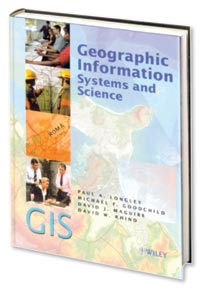Includes the Role of the Internet in GIS Development and Delivery
Groundbreaking Book Investigates the Foundations, Issues, and Uses of GIS
There are at least a dozen introductory textbooks on GIS. Most of them were written from a 20th century perspective, with what is increasingly seen as an overly technical  focus. The brand new Geographic Information Systems and Science by Paul Longley, Michael Goodchild, David Maguire, and David Rhind breaks new ground in many important areas.
focus. The brand new Geographic Information Systems and Science by Paul Longley, Michael Goodchild, David Maguire, and David Rhind breaks new ground in many important areas.
Geographic Information Systems and Science discusses in equal measure scientific foundations (GIScience), technological issues (GISystems), and how GIS is embedded and used in the real world (GIStudies). To get some inkling of what these different perspectives can bring, consider three contrasting perspectives of a coastline:
- GIScience—How long is the coastline of Norway, when measured at a range of geographic scales?
- GISystems—What type of data structure can most efficiently represent Norway's coastline in a GIS database?
- GIStudies—How can the coastal zone best be managed to meet diverse (and sometimes competing) needs of tourism, transportation, and local service provision?
Geographic Information Systems and Science takes on board the Internet revolution and investigates the role of the Internet in GIS development, delivery, and use. Rather than ghettoize the Internet in a single chapter, its influence pervades almost every chapter. There is everything from the history of GIS on the Internet to the impact of the Net in online community planning projects, to the Internet as a resource for finding more about GIS principles and practice.
Because GIS in the real world is all about solving real application problems, the book is laced with case studies chosen from around the globe about, for example, local government tax assessment, network logistics, environmental modeling, utility asset management, and retail store location analysis. There are also many short essays about people in GIS and their key contributions to the subject.
Perhaps a first for GIS textbooks is the extensive treatment of management issues. This includes both the use of GIS in management and the management of GIS. The authors recognize that management is a critical but often neglected aspect of GIS. What is the best way to be successful in acquiring and implementing a GIS? To ensure that you stay in Business, how do you minimize risks, understand local and international law, and nurture and grow your GIS?
Geographic Information Systems and Science itself is but one part of a still greater learning resource. Each chapter contains links to virtual support material, including Web-based further reading, and sites with complementary ideas, case studies, and data sources. The book has its own Web site (www.wiley.com/gis) that lists all the hundreds of URLs referenced as well as a list of acronyms, further reading, and updates and corrections. Also at the site are freely accessible copies of most of the chapters in the first book produced by the team—Geographical Information Systems: Principles and Applications (Longman, 1991)—as well as instructors' manuals for educators and trainers.
A very significant feature of Geographic Information Systems and Science is the linkage to the Esri Virtual Campus (Esri Training and Education). The Virtual Campus has a new module called "Turning Data into Information," by the four authors, specifically about material in the book. Additionally, there are extensive cross linkages between the book and other Virtual Campus courses. Students can now use the book and the campus as an integrated part of their GIS education.
Especially of interest to Esri users is the fact that much of the material provides useful background to an understanding of ArcGIS 8.1 and is complementary to several other Esri Press books, such as Modeling Our World by Michael Zeiler. There are chapters on the nature of geographic data, geographic representation, georeferencing, error and uncertainty, databases, data collection, data modeling, visualization and cartography, GIS software, and g-Business.
According to Esri President Jack Dangermond, "Geographic Information Systems and Science is a great contribution to our understanding of the evolution of GIS by the leading international team of authors." David Maguire, Esri director of products, adds, "At the outset, our goal was to present a modern view of GIS that reflected how it was used in the real world and to provide an enriching and complete educational experience integrating digital and printed media."
Geographic Information Systems and Science (2001) by Paul A. Longley, Michael F. Goodchild, David J. Maguire, and David W. Rhind is published by John Wiley and Sons Ltd., Chichester, and Esri Press (ISBN 0-471-89275-0) and is available from the Esri GIS Store at http://store.esri.com.
